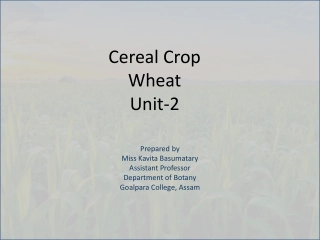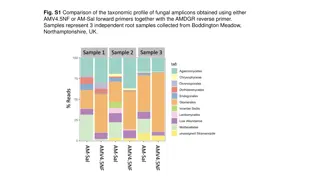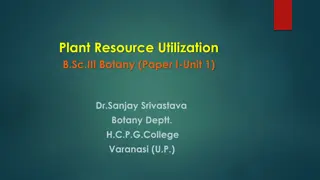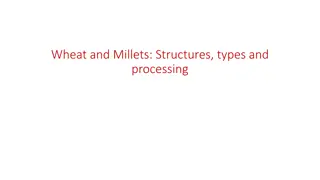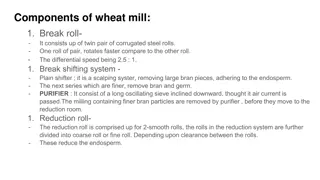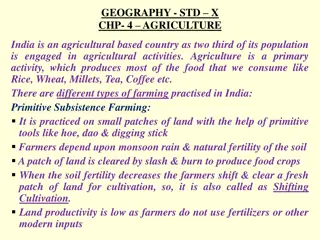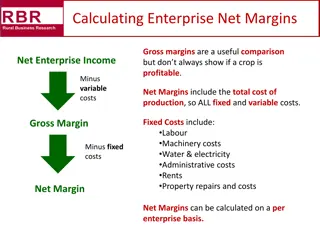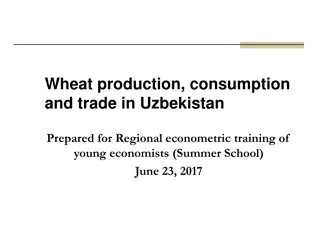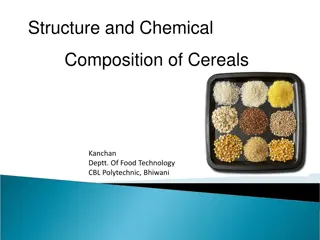Overview of Wheat Production in India
Wheat is a significant cereal crop in India, with a total area of about 29.8 million hectares dedicated to its cultivation. India ranks 2nd globally in wheat production, with production crossing 95 million tonnes in the year 2013-2014. The geographical conditions required for wheat cultivation in India include specific temperature, rainfall, soil, and land requirements. Uttar Pradesh and Madhya Pradesh are leading states in wheat production, contributing significantly to India's total wheat output.
Download Presentation

Please find below an Image/Link to download the presentation.
The content on the website is provided AS IS for your information and personal use only. It may not be sold, licensed, or shared on other websites without obtaining consent from the author. Download presentation by click this link. If you encounter any issues during the download, it is possible that the publisher has removed the file from their server.
E N D
Presentation Transcript
S. MHESWARI GUEST LECTURER IN GEOGRAPHY III B.Sc. GEOGRAPHY GEOGRAPHY OF INDIA TITLE : WHEAT IN INDIA 28.08.2020
WHEAT INDIA Wheat is the main cereal crop in India.The total area under the crop is about 29.8 million hectares in the country. India stands at 2nd position in wheat production in the world and in the year 2013-2014, wheat production crossed the mark of 95 Million Tonnes. Indian wheat is largely a soft/medium hard, with medium protein somewhat similar to U.S. hard white wheat. Wheat grown in central and western India is typically hard, with high protein and high gluten content. Wheat is an important Rabi Crop, which is grown between September and December and harvested between February and May
Geographical Conditions of Wheat in India: Wheat is the 2nd most important food crop of India. It is the crop of temperate region. In India it is grown in winter. It is more dependent on climate than soil. The geographical condition required for Wheat Cultivation are mentioned below:- 1. Temperature: Wheat requires 14 to 18 C temperature. High temperature is harmful for the cultivation of wheat. 2. Rainfall: 50 cm to 100 cm rainfall is required for wheat cultivation. In the primary stage cold moisture rich climate and at the time of harvesting bright hot climate is required. 3. Soil: Fertile alluvial soil or mixed soil is ideal for wheat cultivation. 4. Land: Plain land or gentle slope is ideal for wheat cultivation.
Uttar Pradesh Uttar Pradesh is the leading player in wheat production in India and leads the front with more than 34% share of total wheat production in India. Wheat is grown in more than 96 Lakh hectares out of 168 Lakh hectares of cultivated area. Wheat is mainly grown in three regions in Uttar Pradesh, which include Western Uttar Pradesh and Northern Uttar Pradesh. Out of three regions, Eastern Uttar Pradesh is the largest wheat growing region with more than 52 Lakh hectares of land under wheat cultivation. Triticum aestivum is the specie of wheat, which is grown in Uttar Pradesh. Also, the yield of wheat production in Uttar Pradesh is more than 3,100 kg per hectare. Production:300.010 Lakh Metric Tonnes Eastern Uttar Pradesh,
Madhya Pradesh Madhya Pradesh also known as The Heart of India is the next leading wheat producing state, which account for more than 8.5% of total wheat production in India. Sharbati and Durum are the famous varieties of wheat,which are produced in districts like Sehore, Hoshangabad, Vidisha, Satna, Raisen, etc. These districts have medium and deep soils, which are suitable for growing wheat. Sharbati wheat is known for its great taste and softness and always in a great demand in different markets of the country. Wheat is grown in a large area in Madhya Pradesh with more than 43 Lakh Hectares of land under wheat cultivation. The wheat productivity of Madhya Pradesh is more than 1,700 Kg/Hectare. Production:76.271 Lakh Metric Tonnes
Punjab The Land of Five Rivers, Punjab is another leading wheat producing state in the country and stand at 3rdin the list of top 10 largest wheat producing states in India 2018. Punjab has more than 40 Lakh hectares of cultivated land and out of which,wheat is grown in more than 35 Lakh hectares of land. Punjab is a state with one of the most fertile soils in India and account for more than 18% share of total wheat production in the country, which is 2nd highest after Uttar Pradesh. The species of wheat,which are grown in Punjab are Triticum aestivum and Triticum durum. Amritsar,Ludhiana,Faridkot,Sangrur and Patiala are some of the major wheat producing districts in Punjab. These districts collectively contribute to more than 60% of total wheat produced in the state. Production:164.720 Lakh Metric Tonnes
Haryana Haryana is the next wheat producing state, which produces more than 116 Lakh Metric Tonnes of wheat annually. Wheat is the main crop of Haryana, which is grown in more than 25 Lakh hectares out of over 35 Lakh hectares of cultivated land. Haryana is among the states with the highest wheat productivity of more than 4 Tonnes/Hectare. Triticum aestivum is the specie of wheat, which is grown in districts like Rohtak,Gurgaon,Karnal and Hissar. Production:116.30 Lakh Metric Tonnes
Rajasthan Rajasthan, also known as Land of Kings is placed at 5th in the list of top 10 largest wheat producing states in India 2016.Wheat is grown in more than 24 Lakh Hectares of area in Rajasthan and accounts for more than 8% of totalwheat production in India. Triticum aestivum and Triticum durum are the species of wheat, Ganganagar, Udaipur, Jaipur, Kota and Tonk district of Rajasthan. Rajasthan produces more than 72 Lakh Metric Tonnes of wheat and owns the wheat productivity of more than 2,900 Kg/Hectare. Production:72.145 Lakh Metric Tonnes which are grown in
Bihar With Wheat Production of 40.976 Lakh Metric Tonnes, Bihar is next on this list. Bihar has more than 50 Lakh Hectares of cultivated areas and out of which, wheat is grown in over 21 Lakh hectares. Bihar has wheat yield of more than 1,900 Kg/Hectare and produces more than 40 Lakh Metric Tonnes of wheat. Siwan, Nalanda, Bhojpur and Begusarai are districts, which account for maximum produced in Bihar. Production:40.976 Lakh Metric Tonnes share of wheat
Gujarat Gujarat is the next wheat producing state and account for more than 4% of total wheat produced in the country. In Gujarat, wheat is grown in a large area, which is more than 12 Lakh hectares of land. Also, Gujarat has productivity of Tonnes/Hectare. Triticum aestivum is the wheat specie, which is grown in many districts of Gujarat that include Kheda, Mehsana, Bhavnagar. Production:40.195 Lakh Metric Tonnes a good wheat more than 3 Rajkot and
West Bengal 8th position is occupied by West Bengal, which produces more than 8 Lakh Metric Tonnes of wheat. West Bengal has more than 3 Lakh hectares of land under wheat cultivation and owns the wheat productivity Kg/Hectare. Production: 8.744 Lakh Metric Tonnes of 2,700
Uttarakhand Uttarakhand is in 9th place in this list,which join the league of leading wheat producers with more than 8 Lakh Metric Tonnes production every year. The area of wheat production exceeds 3.7 Lakh hectares of land. Production: 8.780 Tonnes of wheat in this state Lakh Metric
Maharashtra Maharashtra is ranked 10th in the list of top 10 producing states in India 2018. In this state, Triticum dicoccum wheat is produced, which is grown in the valleys of rivers Krishna and Tapi. In Maharashtra, wheat is grown in area of more than 20 Lakh hectares, which account 4.5% of the total area of the country in which wheat is cultivated. Production: 23.010 Tonnes largest wheat like Godavari, Lakh Metric
TRADE World trade in wheat is greater than for all other crops combined. Demand of India's wheat in the world shows a rising trend. The country has exported 2,17,354.22 MT of wheat to the world for the worth of Rs. 439.16 crores/61.84 USD Millions during the year of 2019-20.



